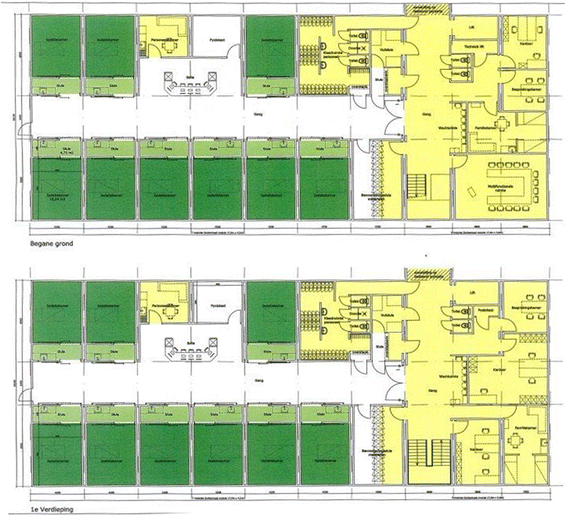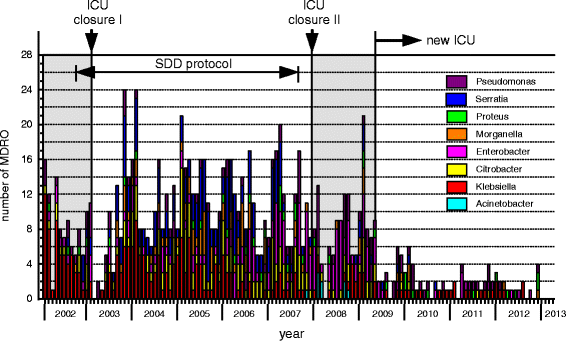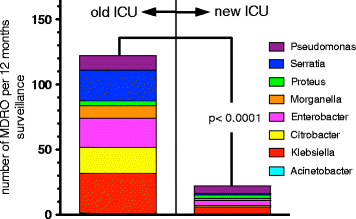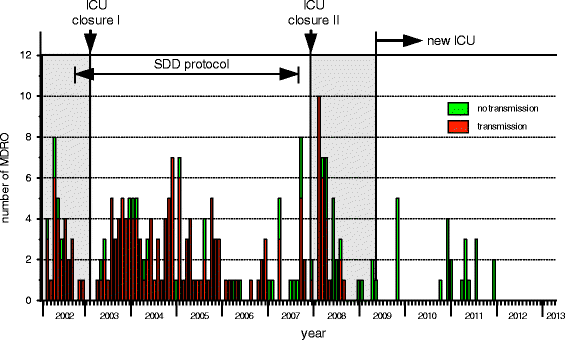Impact of single room design on the spread of multi-drug resistant bacteria in an intensive care unit
- PMID: 29177048
- PMCID: PMC5688743
- DOI: 10.1186/s13756-017-0275-z
Impact of single room design on the spread of multi-drug resistant bacteria in an intensive care unit
Abstract
Background: Cross-transmission of nosocomial pathogens occurs frequently in intensive care units (ICU). The aim of this study was to investigate whether the introduction of a single room policy resulted in a decrease in transmission of multidrug-resistant (MDR) bacteria in an ICU.
Methods: We performed a retrospective study covering two periods: between January 2002 and April 2009 (old-ICU) and between May 2009 and March 2013 (new-ICU, single-room). These periods were compared with respect to the occurrence of representative MDR Gram-negative bacteria. Routine microbiological screening, was performed on all patients on admission to the ICU and then twice a week. Multi-drug resistance was defined according to a national guideline. The first isolates per patient that met the MDR-criteria, detected during the ICU admission were included in the analysis. To investigate the clonality, isolates were genotyped by DiversiLab (bioMérieux, France) or Amplified Fragment Length Polymorphism (AFLP). To guarantee the comparability of the two periods, the 'before' and 'after' periods were chosen such that they were approximately identical with respect to the following factors: number of admissions, number of beds, bed occupancy rate, per year and month.
Results: Despite infection prevention efforts, high prevalence of MRD bacteria continue to occur in the original facility. A marked and sustained decrease in the prevalence of MDR-GN bacteria was observed after the migration to the new ICU, while there appear to be no significant changes in the other variables including bed occupancy and numbers of patient admissions.
Conclusion: Single room ICU design contributes significantly to the reduction of cross transmission of MRD-bacteria.
Conflict of interest statement
Ethics approval and consent to participate
The study was subjected to an ethical review by the “Medisch Ethische Toetsingscommissie Twente (METC)”, Medical School Twente, PoB 50,000, 7500 KA Enschede, the Netherlands. The study was judged as not meeting the criteria for an assessment by a medical ethical committee according to the Dutch low, with the ID number: METC/17247.hal.
Consent for publication
Not applicable. The study was judged as not meeting the criteria for an assessment by a medical ethical committee according to the Dutch low, with the ID number: METC/17247.hal.
Competing interests
The authors declare that they have no competing interests.
Publisher’s Note
Springer Nature remains neutral with regard to jurisdictional claims in published maps and institutional affiliations.
Figures







References
-
- Crnich CJ, Safdar N, Maki DG. The role of the intensive care unit environment in the pathogenesis and prevention of ventilator-associated pneumonia. Respir Care. 2005;50:813–836. - PubMed
LinkOut - more resources
Full Text Sources
Other Literature Sources
Miscellaneous

